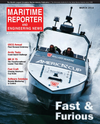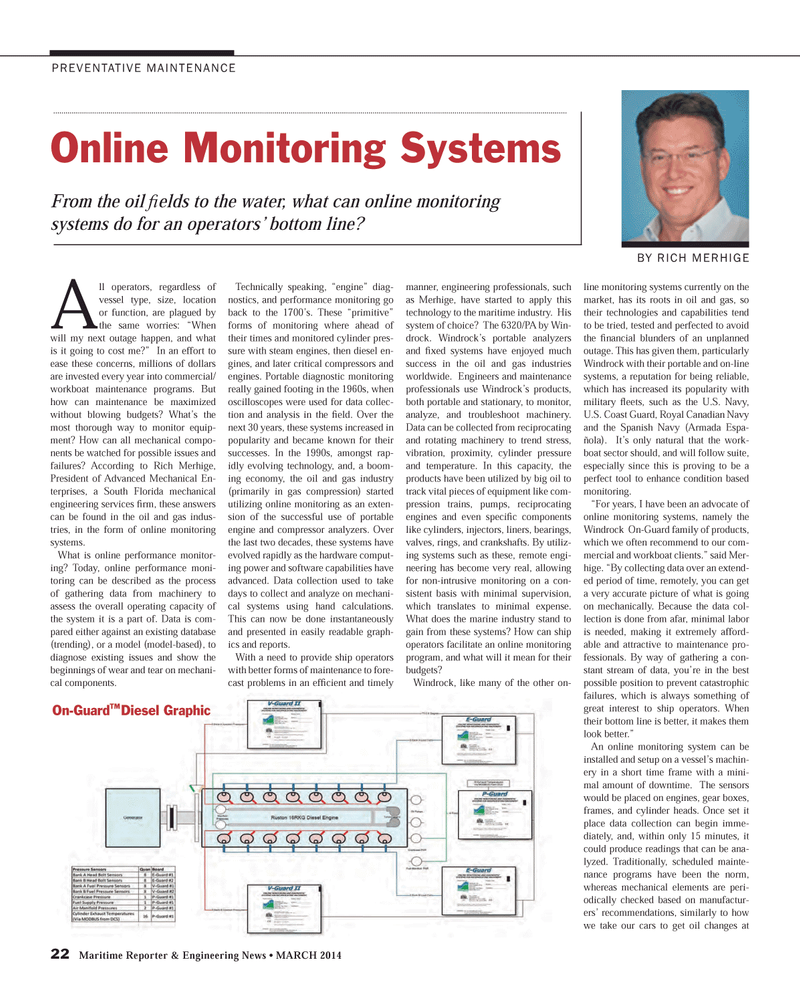
Page 22: of Maritime Reporter Magazine (March 2014)
U.S. Coast Guard Annual
Read this page in Pdf, Flash or Html5 edition of March 2014 Maritime Reporter Magazine
22 Maritime Reporter & Engineering News • MARCH 2014
PREVENTATIVE MAINTENANCE
A ll operators, regardless of vessel type, size, location or function, are plagued by the same worries: “When will my next outage happen, and what is it going to cost me?” In an effort to ease these concerns, millions of dollars are invested every year into commercial/ workboat maintenance programs. But how can maintenance be maximized without blowing budgets? What’s the most thorough way to monitor equip- ment? How can all mechanical compo- nents be watched for possible issues and failures? According to Rich Merhige,
President of Advanced Mechanical En- terprises, a South Florida mechanical engineering services fi rm, these answers can be found in the oil and gas indus- tries, in the form of online monitoring systems.
What is online performance monitor- ing? Today, online performance moni- toring can be described as the process of gathering data from machinery to assess the overall operating capacity of the system it is a part of. Data is com- pared either against an existing database (trending), or a model (model-based), to diagnose existing issues and show the beginnings of wear and tear on mechani- cal components.
Technically speaking, “engine” diag- nostics, and performance monitoring go back to the 1700’s. These “primitive” forms of monitoring where ahead of their times and monitored cylinder pres- sure with steam engines, then diesel en- gines, and later critical compressors and engines. Portable diagnostic monitoring really gained footing in the 1960s, when oscilloscopes were used for data collec- tion and analysis in the fi eld. Over the next 30 years, these systems increased in popularity and became known for their successes. In the 1990s, amongst rap- idly evolving technology, and, a boom- ing economy, the oil and gas industry (primarily in gas compression) started utilizing online monitoring as an exten- sion of the successful use of portable engine and compressor analyzers. Over the last two decades, these systems have evolved rapidly as the hardware comput- ing power and software capabilities have advanced. Data collection used to take days to collect and analyze on mechani- cal systems using hand calculations.
This can now be done instantaneously and presented in easily readable graph- ics and reports.
With a need to provide ship operators with better forms of maintenance to fore- cast problems in an effi cient and timely manner, engineering professionals, such as Merhige, have started to apply this technology to the maritime industry. His system of choice? The 6320/PA by Win- drock. Windrock’s portable analyzers and fi xed systems have enjoyed much success in the oil and gas industries worldwide. Engineers and maintenance professionals use Windrock’s products, both portable and stationary, to monitor, analyze, and troubleshoot machinery.
Data can be collected from reciprocating and rotating machinery to trend stress, vibration, proximity, cylinder pressure and temperature. In this capacity, the products have been utilized by big oil to track vital pieces of equipment like com- pression trains, pumps, reciprocating engines and even specifi c components like cylinders, injectors, liners, bearings, valves, rings, and crankshafts. By utiliz- ing systems such as these, remote engi- neering has become very real, allowing for non-intrusive monitoring on a con- sistent basis with minimal supervision, which translates to minimal expense.
What does the marine industry stand to gain from these systems? How can ship operators facilitate an online monitoring program, and what will it mean for their budgets?
Windrock, like many of the other on- line monitoring systems currently on the market, has its roots in oil and gas, so their technologies and capabilities tend to be tried, tested and perfected to avoid the fi nancial blunders of an unplanned outage. This has given them, particularly
Windrock with their portable and on-line systems, a reputation for being reliable, which has increased its popularity with military fl eets, such as the U.S. Navy,
U.S. Coast Guard, Royal Canadian Navy and the Spanish Navy (Armada Espa- ñola). It’s only natural that the work- boat sector should, and will follow suite, especially since this is proving to be a perfect tool to enhance condition based monitoring. “For years, I have been an advocate of online monitoring systems, namely the
Windrock On-Guard family of products, which we often recommend to our com- mercial and workboat clients.” said Mer- hige. “By collecting data over an extend- ed period of time, remotely, you can get a very accurate picture of what is going on mechanically. Because the data col- lection is done from afar, minimal labor is needed, making it extremely afford- able and attractive to maintenance pro- fessionals. By way of gathering a con- stant stream of data, you’re in the best possible position to prevent catastrophic failures, which is always something of great interest to ship operators. When their bottom line is better, it makes them look better.”
An online monitoring system can be installed and setup on a vessel’s machin- ery in a short time frame with a mini- mal amount of downtime. The sensors would be placed on engines, gear boxes, frames, and cylinder heads. Once set it place data collection can begin imme- diately, and, within only 15 minutes, it could produce readings that can be ana- lyzed. Traditionally, scheduled mainte- nance programs have been the norm, whereas mechanical elements are peri- odically checked based on manufactur- ers’ recommendations, similarly to how we take our cars to get oil changes at
Online Monitoring Systems
From the oil fi elds to the water, what can online monitoring systems do for an operators’ bottom line?
BY RICH MERHIGE
On-Guard Diesel Graphic
TM
MR #3 (18-25).indd 22 3/4/2014 2:21:11 PM

 21
21

 23
23
